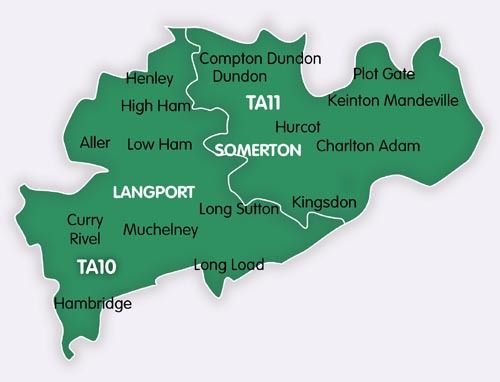Somerton & Langport
Somerton
Somerton (/ˈsʌmərtən/ SUM-ər-tən) is a town and civil parish in the English county of Somerset. It gave its name to the county and was briefly, around the start of the 14th century, the county town, and around 900 was possibly the capital of Wessex. It has held a weekly market since the Middle Ages, and the main square with its market cross is today popular with visitors. Situated on the River Cary, approximately 8.8 miles (14.2 km) north-west of Yeovil, Somerton has its own town council serving a population of 4,697 as of 2011.
Residents are often referred to locally as Somertonians. The civil parish includes the hamlets of Etsome, Hurcot, Catsgore, and Catcombe.
Archaeological remains at Somerton are evidence of a Celtic settlement. The discovery of a high status cemetery in 2019, suggests that these local people adopted a more Roman lifestyle.[3] During the Anglo-Saxon era, Somerton was an important political and commercial centre. After the Norman conquest of England the importance of the town declined, despite being the county town of Somerset in the late thirteenth century and early fourteenth century. Having lost county town status, Somerton then became a market town in the Middle Ages, whose economy was supported by transport systems using the River Parrett, and later rail transport via the Great Western Railway, and by light industries including glove making and gypsum mining.
In the centre of Somerton the wide market square, with its octagonal roofed market cross, is surrounded by old houses, while close by is the 13th century Church of St Michael and All Angels. Somerton also had links with Muchelney Abbey in the Middle Ages. The BBC drama The Monocled Mutineer was filmed in Somerton from 1985 to 1986.
Langport
Langport is a small town and civil parish in Somerset, England, 5 miles (8 km) west of Somerton. The parish, which covers only part of the town, has a population of 3,578. Langport is contiguous with Huish Episcopi, a separate parish that includes much of the town's outskirts.
Langport (old forms are "Langeberga" and "Langeport") consists of two parts, one on the hill and one by the River Parrett. The former owed its origin to its defensible position, and the latter its growth to its facilities for trade on the chief river of Somerset. Eilert Ekwall translates it as "long town" or "long market". Its name looks like Anglo-Saxon for "long port", but it may be "long market place" that could have been on the causeway that is now Bow Street.
Many of the houses in Bow Street tilt backwards due to settlement of the land behind the causeway. It is speculated that Langport is the place mentioned in old Welsh sources as "Llongborth" = "Ship-port", the site of the Battle of Llongborth. "Longphort" is a term used in Ireland for a Viking ship enclosure or shore fortress, with an identical etymology. Langport was previously also known as Langport Eastover, with the part on the western bank being Langport Westover, now known just as Westover. Langport is on the ancient way from Glastonbury to Taunton.
Langport could have been important during the Roman occupation as there were several villas in the vicinity. It was one of the forts listed in the Burghal Hidage indicating its strategic position for King Alfred, as well as being close to the royal centre of Somerton. In 1086, according to Domesday Book, it had 34 resident burgesses and was worth the then large sum of £79 10s 7d.
The parish of Combe was part of the Kilmersdon Hundred, while Langport Eastover was within the Hundred of Pitney.
On 10 July 1645, the Battle of Langport was fought here, in which the last effective Royalist field army was destroyed and the Parliamentary victory in the Civil War became all but inevitable. When the Royalists retreated through the town many were killed by the bridge over the Parrett, and many of the buildings were set on fire. Although one authority states this was an act of the Parliamentary cavalry, reading contemporary accounts of the battle it is clear that the Royalist cavalry set the lower town on fire in the (vain) hope that this would hinder the pursuit led by Cromwell's cavalry.
In World War II Langport was the site of a United States Army military prison or Disciplinary Training Center.
Contact us if you would like to advertise in this issue.


